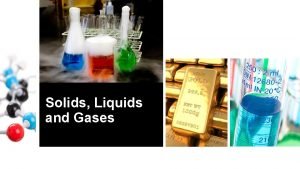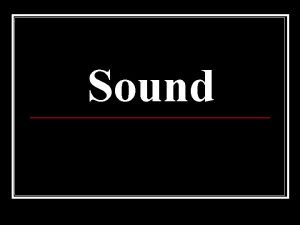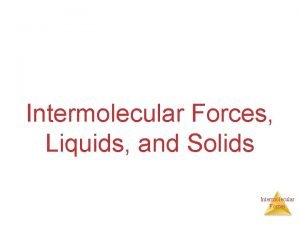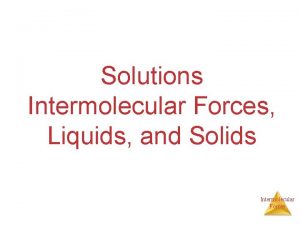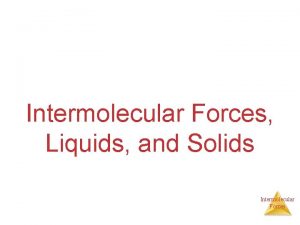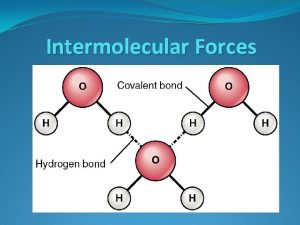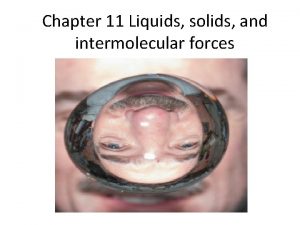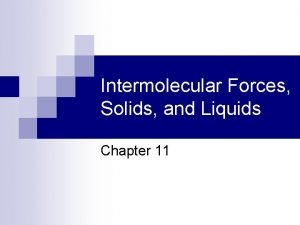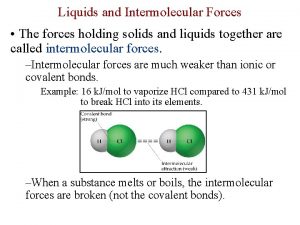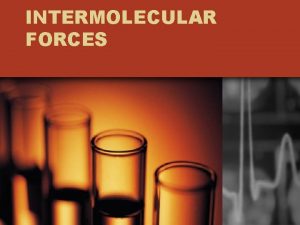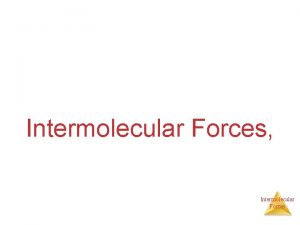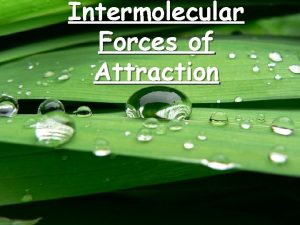Chemistry 100 Chapter 12 Liquids Solids Intermolecular Forces






















- Slides: 22

Chemistry 100 Chapter 12 Liquids, Solids, & Intermolecular Forces

London dispersion forces Dipole-dipole interaction Intermolecular forces < ionic bond covalent bond Hydrogen bonding Intramolecular forces Ion-dipole interaction

London dispersion forces Attractive forces between all molecules Only forces between nonpolar covalent molecules He He He δ- _ 2+ _ δ+ 2+ Original Temporary Dipole No Polarity He δ- _ _ δ+ 2+ Original Temporary Dipole He δ- _ _ δ+ 2+ Induced Temporary Dipole He + 2+ _ _

London dispersion forces He: T↓ Kinetic energy ↓ Move slower T = -240°C (1 atm) → liquid Attractive forces become more important liquid

London dispersion forces: Size Melting Pt. (℃) Boiling Pt. (℃) He -270 (3. 5 K) -269 (4. 2 K) Ne -249 -246 Ar -189 -186 Kr -157 -153 Xe -112 -108 F 2 -220 -188 Cl 2 -101 -34 Br 2 -7 59 I 2 114 184 As size increases (more shells) More electrons and protons melting and boiling points increase

Dipole-Dipole Interactions Attractive force between two polar molecules. It is stronger than London dispersion forces ↑ intermolecular forces ↑ boiling point

Hydrogen Bonds A special case of dipole-dipole Between H bonded to O, N, or F (high electronegativity) → δ+ and a nearby O, N, or F → δIt is stronger than Dipole-Dipole Interactions & London dispersion forces H 2 O High boiling point surface tension

Hydrogen bonding δ+ CH 3 COOH Acetic acid δ-

H-bonding in our body H-bond Protein (α-helix) DNA

Ion-Dipole Interactions Attractive force between ionic compounds and polar molecules. It is the strongest attraction forces.

Evaporation equilibrium Vapor pressure: the pressure of a gas in equilibrium with its liquid form in a closed container. Boiling point: the temperature at which the vapor pressure of a liquid is equal to the atmospheric pressure.

Evaporation vacuum 670 mm Measuring vapor pressure of liquids

Evaporation normal boiling point: the temperature at which a liquid boils under a pressure of 1. 00 atm. Die th yl e the r 1 atm. = 760 mm Hg CH 3 OH H 2 O

Evaporation Factors that affect boiling point: 1. Intermolecular forces: London dispersion forces < Dipole-Dipole Int. < H-bonding < Ion-Dipole Int. 2. Number of sites for intermolecular interactions (surface area): Larger surface (more electrons) more sites for London b. p. CH 3 -CH 2 -CH 3 > CH 3 -CH 2 -CH 3 _ 3. Molecular shape: With the same molecular weight. _ linear CH 3 -CH 2 -CH 3 > spherical CH 3 -C- CH 3

London Forces: Shape Rod-like molecules have a greater surface area, more contact points for molecules to join together. Boiling Points: 36°C Ball or spherical shaped molecules have fewer contact points for molecules to join together. 10°C

Solid Crystalline solid (Network solids) Amorphous solid

Crystalline solids (Network solids) Ionic solids: Consist of ions (metal-nonmetal) Na. Cl Stable - High melting points Crystalline solid Molecular solids: Consist of molecules. Sugar, Ice Lower melting points London dispersion forces, Dipole-Dipole interaction, H-Bond Atomic solids: Consist of atoms. Diamond, Graphite, Metals Different melting points (because of forces between atoms).

Solidification (Crystallization): change phase from liquid to solid. Fusion (Melting): change phase from solid to liquid. Sublimation: change phase from solid directly into the vapor. Dry ice (solid CO 2)

Heating/Cooling Curve Heat added (cal) during the phase changes, the temperature stays constant.

Heat and physical state Molar heat of fusion: Energy required to melt 1 mol of a solid. (For ice: 6. 02 k. J/mol) Molar heat of vaporization: Energy required to vaporize 1 mol of liquid. (For water: 40. 6 k. J/mol) We need more energy for vaporization than fusion: Why? To separate molecules enough to form a gas all of the intermolecular forces must be overcome.

Example 1 Ex. 12. 2 Page 422: Calculate the amount of ice in grams that, upon melting (at 0 ºC), absorbs 237 k. J × Mol H 2 O 1 mol H 2 O 6. 02 k. J g H 2 O 18. 02 g H 2 O × = 709 g 1 mol H 2 O

Example 2 Calculate the amount of heat required to melt 25. 0 g of ice (at 0ºC). g H 2 O Mol H 2 O k. J
 100 100 100 100 100
100 100 100 100 100 Intra vs intermolecular forces
Intra vs intermolecular forces δ+
δ+ Intramolecular forces vs intermolecular forces
Intramolecular forces vs intermolecular forces Idf
Idf Chapter 14 solids liquids and gases worksheet answers
Chapter 14 solids liquids and gases worksheet answers Kinetic molecular theory of solid
Kinetic molecular theory of solid Chapter 11 - states of matter: liquids and solids
Chapter 11 - states of matter: liquids and solids Thermal expansion and contraction examples
Thermal expansion and contraction examples Solids liquids and gases section 2 properties of fluids
Solids liquids and gases section 2 properties of fluids Solid liquid gas information
Solid liquid gas information Solid and liquid venn diagram
Solid and liquid venn diagram The properties of solids liquids and gases
The properties of solids liquids and gases Why is gas easier to compress than a liquid
Why is gas easier to compress than a liquid Combined gas law def
Combined gas law def Adhesive force
Adhesive force Filtration
Filtration Liquids and solids menu
Liquids and solids menu The science duo physical and chemical changes
The science duo physical and chemical changes Kesler science.com
Kesler science.com Red liquid element
Red liquid element How does sound travel through solids liquids and gases
How does sound travel through solids liquids and gases Liquid information
Liquid information



















